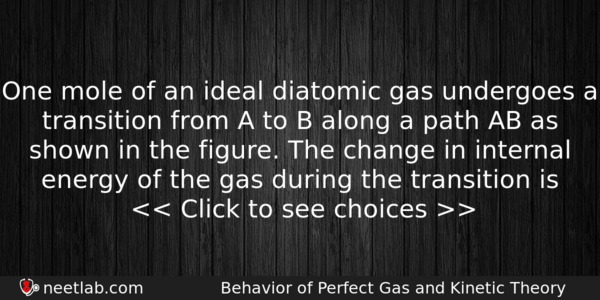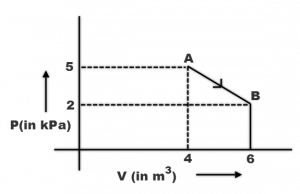| ⇦ | 
| ⇨ |
One mole of an ideal diatomic gas undergoes a transition from A to B along a path AB as shown in the figure.

The change in internal energy of the gas during the transition is
Options
(a) -20 kJ
(b) 20 J
(c) -12 kJ
(d) 20 kJ
Correct Answer:
-20 kJ
Explanation:
No explanation available. Be the first to write the explanation for this question by commenting below.
Related Questions: - A current I ampere flows along the inner conductor of a co-axial cable and returns
- A tuning fork A produces 4 beats per second with another tuning fork B of frequency
- A parallel plate capacitor has 91 plates, all are identical and arranged with same
- X-ray beam can be deflected by
- A gramophone record is revolving with an angular velocity ?. A coin is placed at
Topics: Behavior of Perfect Gas and Kinetic Theory
(34)
Subject: Physics
(2479)
Important MCQs Based on Medical Entrance Examinations To Improve Your NEET Score
- A current I ampere flows along the inner conductor of a co-axial cable and returns
- A tuning fork A produces 4 beats per second with another tuning fork B of frequency
- A parallel plate capacitor has 91 plates, all are identical and arranged with same
- X-ray beam can be deflected by
- A gramophone record is revolving with an angular velocity ?. A coin is placed at
Topics: Behavior of Perfect Gas and Kinetic Theory (34)
Subject: Physics (2479)
Important MCQs Based on Medical Entrance Examinations To Improve Your NEET Score
18000+ students are using NEETLab to improve their score. What about you?
Solve Previous Year MCQs, Mock Tests, Topicwise Practice Tests, Identify Weak Topics, Formula Flash cards and much more is available in NEETLab Android App to improve your NEET score.
Share this page with your friends

ΔU = nCΔT
Also, T = PV/nR
Now,
ΔT = T-T => [PV – PV] / nR
ΔU = nR/¥-1 {PV- PV / nR} [here, ¥ = gamma]
(nR will be cancelled out)
We get,
{-8 x 10^3} / {2/5} = -20kJ.
Hope it helps 🙂